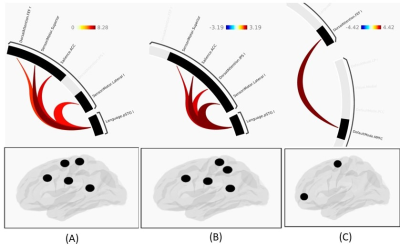3150
Characteristics of frequency specificity associated with memory cognition.1Department of NMR, All India Institute of Medical Sciences, New Delhi, India
Synopsis
Spoken word and its underlying semantic cognition has a complex interaction and is an unexplored domain. We designed a 1-back auditory working memory task to understand the semantic context, where individual’s frequency characteristics are quantified through audiometric tests. Task connectome analysis is parametrically modulated with frequency parameters to highlight the effect of frequency specificity, to distinguish the characteristics of auditory cognition from perception to cognition aspect. The semantic cognition is associated to frequency specific nature of stimuli.
Introduction
Audiological information associated with meaningful words is decimated in bins of frequency with variable amplitude for pitch and noise, and is processed through a complex cognitive network1. Specificity of frequency associated with semantic cognition is still an unexplored domain of study. The objective of this study is to explore the perception of words associated with frequency and auditory semantic cognition.Method
A 1-back auditory working memory (AWM) task was designed (single syllable words were recorded in a soundproof room with 35 dB ambient noise) and the cues were presented as stimuli for a duration of 500-1000ms with amplification of 95db to remain audible during fMRI task. Healthy volunteers (n=61) underwent an fMRI study for the 1-back AWM task on 3 T MR scanner (Ingenia 3T, M/s Philips). They were screened for pure tone audiometry (PTA) from 125 Hz to 16kHz, brain stem response (ABR) and Distortion product otoacoustic emissions (DPOAE) prior to fMRI study. PTA response of individuals were input as modulation parameter (orthogonalized to HRF function) with gPPI based network level interaction with p<0.05 FDR corrected threshold to understand the frequency characteristics of hemodynamic changes associated with the memory-recall interaction.Result
Network level interaction for memory component revealed single cluster interaction of Language network at posterior supratemporal gyrus (pSTG l) with lateral and superior sensorimotor (l) with T(60)=2.89,2.52 with FDR p=0.005, 0.014 respectively. Additionally, pSTG (l) interaction with salience (ACC) and Dorsal Attention-l (IPS) network with T= 3.19,2.40 with FDR p=0.002, 0.019 respectively. On parametric input, network interaction neither provided significant result for standard PTA assessment (at 20, 500, 1000 and 4000 Hz) nor for any range of intermediate frequency 125 Hz to 16 kHz. On further analysis at frequency specific interaction, memory network exhibited a modulation for 500Hz range, with an identical network interaction to previous condition with reduced cluster statistics from F=7.24 at p-FDR=0.041 to F=5.33 at p-FDR=0.014, and network change from Dorsal Attention (IPS) to Dorsal Attention (FEF-r) with p-FDR=0.016. For memory matched recall condition network interaction between Dorsal Attention (FEF-l) and Default Mode (MPFC) with T= 4.42 p-FDR=0.042 was observed with no significant result from PTA and frequency modulation.Discussion
In 1-back AWM task, interaction of language network with saliency and sensorimotor may be attributed to the underlying cognition associated with memory and recall2. Interaction of dorsal network with language (for memory) and Default network MPFC (for recall) represent ideal perception to attentional framework in top-down approach. AWM task in fMRI setting highlights the aspect of speech in noise (SiN) test with fixed moderate level of noise (from gradient). Individual word holds limited frequency spectrogram, semantics of stimuli is prevalent in memory stage. This frequency modulation condition with difference within attentional framework (from IPS to FEF) may be associated with frequency specificity of stimuli characteristics3 (400-600 Hz). Our work represents frequency specificity in most basic setting of audio signal (single syllable), however such interaction may not be applicable for complex scenarios. For multiple syllables, information perception may deviate from specific frequency to either multiple or modulated frequency range4, which is not considered in this study.Conclusion
Auditory cognition is frequency specific, with characteristics deviating from frequency threshold for each individual. Interpretation at cognitive level for single syllable may deviate slightly in response to frequency characteristics, but would still remain generalised at processing level. Frequency domain specificity for information processing highlights the importance of frequency decimation for auditory cognition, with exclusion of emotional and complex interaction (which is a limitation of this work).Acknowledgements
This work was supported by LSRB, DRDO vide grant no. LSRB-295/PEE&BS/2017.References
1. Grimault, S., Nolden, S., Lefebvre, C., Vachon, F., Hyde, K., Peretz, I., Zatorre, R., Robitaille, N., & Jolicoeur, P. (2014). Brain activity is related to individual differences in the number of items stored in auditory short-term memory for pitch: Evidence from magnetoencephalography. NeuroImage, 94, 96–106. https://doi.org/10.1016/j.neuroimage.2014.03.020
2. Kaiser, J. (2015). Dynamics of auditory working memory. Frontiers in Psychology, 6(613). https://doi.org/10.3389/fpsyg.2015.00613
3. Kumar, S., Joseph, S., Gander, P. E., Barascud, N., Halpern, A. R., & Griffiths, T. D. (2016). A Brain System for Auditory Working Memory. Journal of Neuroscience, 36(16), 4492–4505. https://doi.org/10.1523/JNEUROSCI.4341-14.2016
4. Schneiders, J. A., Opitz, B., Tang, H., Deng, Y., Xie, C., Li, H., & Mecklinger, A. (2012). The impact of auditory working memory training on the fronto-parietal working memory network. Frontiers in Human Neuroscience, 6, 173. https://doi.org/10.3389/fnhum.2012.00173
